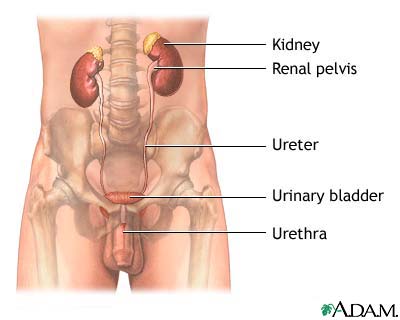Symptoms & Signs
Young children with UTIs may only have a fever, poor appetite, vomiting, or no symptoms at all.
Most urinary tract infections in children only involve the bladder. If the infection spreads to the kidneys, it is called pyelonephritis and may be more serious.
Symptoms of a bladder infection in children include:
- Blood in the urine
- Cloudy urine
- Foul or strong urine odor
- Frequent or urgent need to urinate
- General ill feeling (malaise)
- Pain or burning with urination
- Pressure or pain in the lower pelvis or lower back
- Wetting problems after the child has been toilet trained
Symptoms that the infection may have spread to the kidneys include:
- Chills with shaking
- Fever
- Flushed, warm, or reddened skin
- Nausea
- Pain in the side (flank) or back
- Severe pain in the belly area
- Vomiting
Diagnosis & Tests
A urine sample is needed to diagnose a UTI in children. The sample is examined under a microscope and sent to a lab for a urine culture.
In children who are not toilet trained, getting a urine sample can be difficult. The test cannot be done using a wet diaper. Possible ways to collect a urine sample in very young children include:
- Urine collection bag — A special plastic bag is placed over the child’s penis or vaginal area to catch the urine; this is not the best method because the sample may become contaminated.
- Catheterized specimen urine culture — A plastic tube (catheter) placed into the tip of the penis in boys, or directly into the urethra in girls, collects urine directly from the bladder.
- Suprapubic urine collection — A needle is placed through the skin of the lower abdomen and muscles, into the bladder, and used to collect urine.
If this is your child’s first UTI, special imaging tests may be done to determine why the infection happened, or to see if there is any kidney damage. Tests may include:
- Kidney ultrasound
- X-ray taken while the child is urinating (voiding cystourethrogram)
These studies may be done while the child has an infection, but most often it’s done weeks to several months afterward.
Your doctor will consider many things when deciding if and when a special study is needed, including:
- Is the child younger than 6 months?
- Has the child had infections in the past?
- Is the infection severe?
- Does the child have other medical illnesses?
- Does the child have a problem with the spinal cord or defects of the urinary tract?
- Has the child responded quickly to antibiotics?
Pictures & Images
Male urinary tract
The female and male urinary tracts are relatively the same except for the length of the urethra.
-
Urinary tract infection – children: Overview, Causes
-
Urinary tract infection – children: Symptoms & Signs, Diagnosis & Tests
-
Urinary tract infection – children: Treatment
Review Date : 10/6/2009
Reviewed By : David C. Dugdale, III, MD, Professor of Medicine, Division of General Medicine, Department of Medicine, University of Washington School of Medicine. Also reviewed by David Zieve, MD, MHA, Medical Director, A.D.A.M., Inc.
![]()
